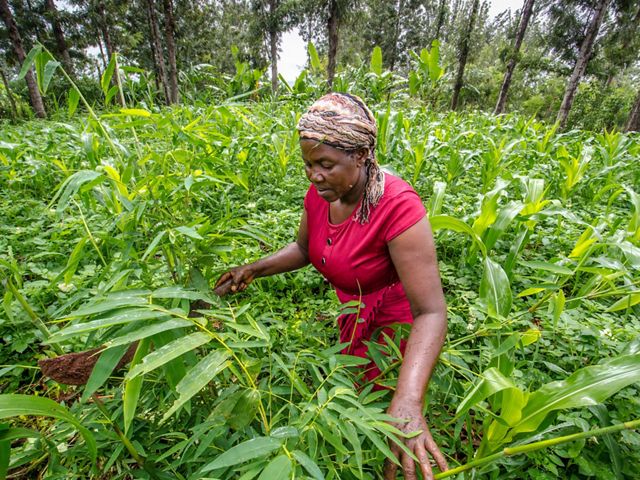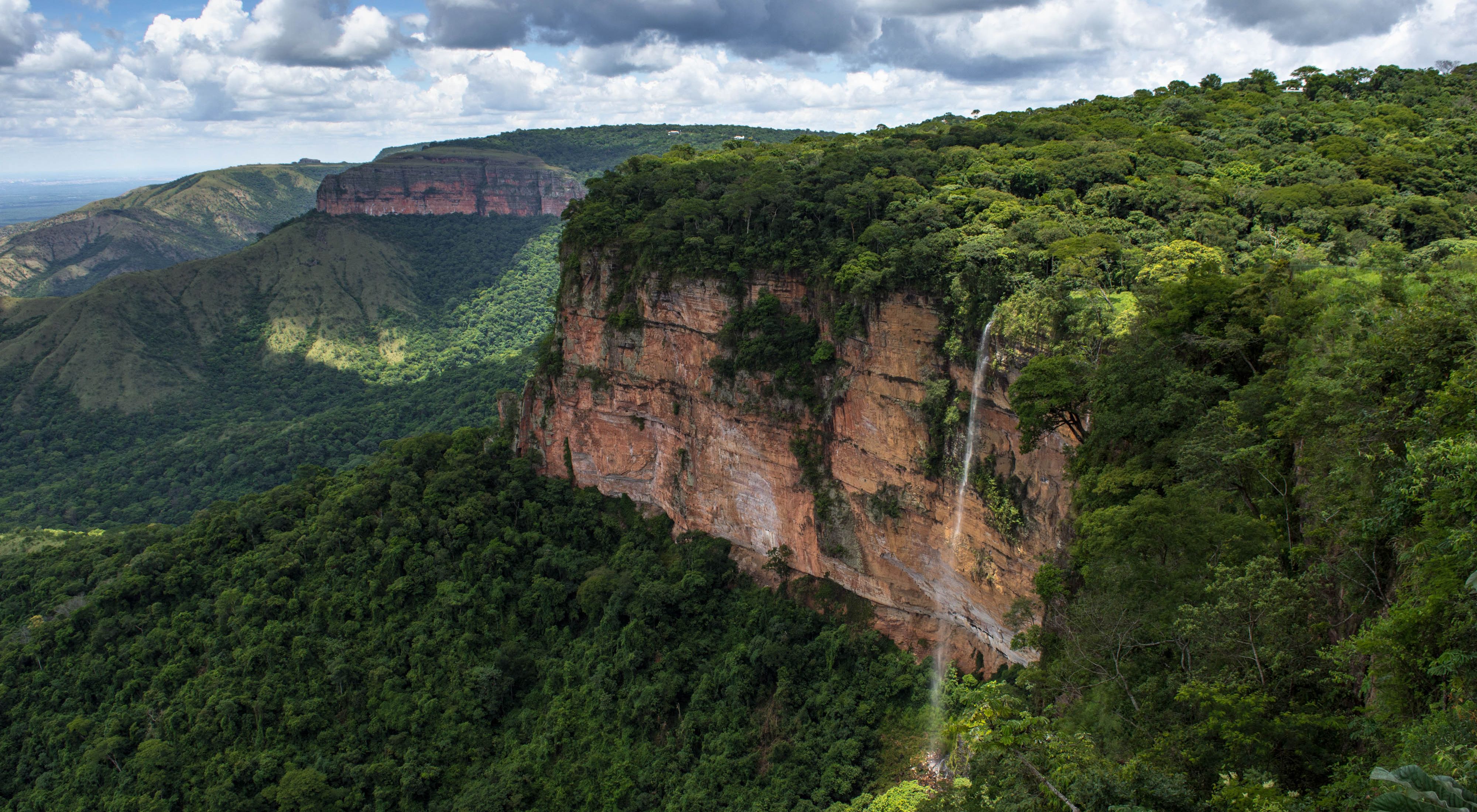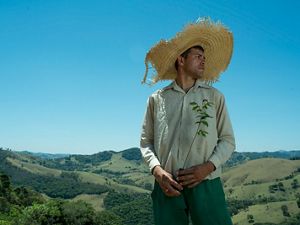Carbon Capture
Cutting forests contributes to climate change. But restoring nature—in all kinds of landscapes—is a powerful tool in the race to stop climate change.
The forests of Brazil’s Serra da Mantiqueira—or at least what’s left of them—can invite hasty judgment. Stretching for 200 miles near the border of Sao Paulo state, the Mantiqueira region is part of the once-vast Atlantic Forest. Centuries ago, this tropical forest famous for its diversity covered an area twice the size of Texas, in a north-south strip parallel to the coast. Today, the Mantiqueira’s mountain slopes stand largely stripped of trees, covered instead with cattle pastures and farm fields. “We have only 12 percent of the original Atlantic Forest left,” says Rubens Benini, a Nature Conservancy scientist who has worked for 22 years to restore Brazil’s forests. “And it is very fragmented.”
The history of the Mantiqueira region is a classic tale of widespread environmental destruction in the name of economic progress. But the story of the region’s tropical forests may not be over, yet.
More than a decade ago, the government of Extrema, a municipality at the Mantiqueira region’s edge, began a tree-planting program as part of an effort to help secure its water supply. The name Mantiqueira comes from an indigenous word meaning “where the clouds lie.” The mountain peaks harbor thousands of springs and streams, waterways that supply Sao Paulo and Rio de Janeiro. Forests help hold water in soils and slow the runoff of rainfall into streams and rivers. Without forests, the Mantiqueira’s streams now shift dramatically from high flows in the rainy season to low flows in dry times. After the work in Extrema helped moderate some stream flows, local farmers and ranchers joined in the reforestation effort—as did TNC. Since 2005, the project has replanted nearly 5,000 acres of forest, and the planting continues.
In 2016, Brazil signed the Paris Agreement and promised to slash its emissions to 43 percent below its 2005 level by 2030. For Benini, that commitment put Extrema’s effort in a new light. Extrema had replanted trees to protect its water, but those same trees were also absorbing carbon dioxide every day. What if there were dozens more Extremas? Hundreds? Brazil could meet part of its climate commitment and better withstand future droughts by putting trees back on marginal lands that had once been forest.
Brazil has since set a target of reforesting 30 million acres across its territory, part of a growing global recognition that nature itself can help nations meet their climate commitments. Managed intelligently, forests, wetlands and soils all have the ability to store carbon. The Conservancy’s own researchers were the first to take a comprehensive look at just how much good conservation and land management changes could do, not just in forests but in all kinds of landscapes.
The answer, it turns out, is a lot.
Benini now leads TNC’s forest-restoration strategy for Latin America. He remains at the forefront of an ambitious initiative to help Brazil take the Extrema model to another 283 municipalities and thereby restore nearly 3 million acres of forest. Doing so will require help from international funders, but such investment will be well worth the price, says Benini. The initiative will take approximately 280 million tons of excess carbon dioxide out of the atmosphere over 30 years—the equivalent of the emissions of more than 55 million cars—and fulfill 10 percent of Brazil’s reforestation goal.
“This is a new way to look at the landscape,” Benini says. “When we are talking about restoration, we’re not just talking about bringing the forest back. We’re talking about tackling climate change.”

On a walk on an early spring day near his home in Harrisonburg, Virginia, Bronson Griscom talks about his team’s research findings in the manner of someone still waking from a profound dream. A tropical forest ecologist by training, TNC’s director of forest carbon science had long had a hunch that nature was a big part of the solution to climate change.
Griscom found a substantial body of published research assessing one or another specific way to use nature to fight climate change, whether it be restoring forests or farming in ways that more closely mimic nature. But, he says, “I was sifting through this [research], thinking, ‘Everybody’s looking at this from different angles, but nobody is really nailing the question: How does it all add up?’ That question hadn’t really been answered at a comprehensive level.”
In 2014, Justin Adams, TNC’s global managing director for lands, asked the same question in a meeting. Griscom approached him afterward. “I was like, ‘We should totally do a little review paper on this,’” says Griscom. He remembers thinking, “It’ll be fun. No big deal. Just run some numbers.”
Adams urged him on—but counseled, as Griscom puts it, “This is a big deal, and we need to do this right.”
The quest to get the numbers right quickly assumed the feel of a scientific expedition. Natural systems are far messier than engineered ones. Calculating just how much carbon, say, an acre of dry steppe grassland can absorb, Griscom learned, “is way more complicated than calculating the climate benefits of a wind turbine.”
It took hiring a team of additional staff and two years of late hours and weekends—plus a dive into esoteric statistical techniques like Monte Carlo simulations, marginal abatement cost curves and the Delphi method for expert elicitation—to finally get an answer.
In 2017, Griscom and his team calculated in the Proceedings of the National Academy of Sciences that natural climate solutions can provide 37 percent of the carbon reductions needed to meet the goals of the Paris climate agreement—while also providing clean air, water and habitat for wildlife.
“We tend to think of nature as a victim,” says Griscom. “But there’s been less attention to the phenomenal resilience and power of nature to heal. The ability of nature to solve problems just doesn’t get enough attention.”
The findings put a spotlight on actions along three broad lines (“The Green Path to a Stable Climate,” opposite). One embraces what many conservationists intuitively guessed: In most places, simply keeping nature intact helps absorb carbon from the atmosphere. Let tropical forests stand, leave coastal marshes undeveloped, and the vegetation in those places will keep on growing and storing carbon.
A second, intriguing strategy centers on managing working lands—such as farms, ranches and timberlands—with carbon in mind. The contribution in terms of carbon is smaller than that of restoration, but the strategy can be applied across large areas without taking lands out of production or harming local economies. The trick is finding the right combination of incentives to persuade agricultural producers and landowners to change how they manage the properties under their care.
The third strategy is to restore natural systems that have been damaged or destroyed, just as Benini and his colleagues hope to do in Brazil. Replanting forests offers enormous potential to capture carbon. But restoring other lands—grasslands, wetlands, coastal mangroves, even sea grasses—also significantly helps the climate picture.
In addition, the paper gets at an overlooked truth about the Paris climate agreement goals: Eliminating the greenhouse gas emissions of fossil fuels is all-important, but cutting emissions alone won’t be enough to keep the temperature rise well below 2 degrees Celsius by 2030. Humankind needs to figure out how to absorb a lot of carbon that’s already in the atmosphere, and Griscom believes his findings offer a clear path for action.
“Nothing,” he says, “is as good as life at sucking carbon out of the atmosphere. There’s no machine we have that’s as good as life.”
Infographic
The Green Path to
a Stable Climate
we must cut 30 gigatons a year of carbon emissions by 2030 if we are to keep global temperature increases well below 2 degrees Celsius, (3.6 degrees Fahrenheit). Nature can reduce more than one-third of the emissions needed to hit this goal if countries invest in carbon-storing forests, grasslands, wetlands and farmlands.
we must cut 30 gigatons a year of carbon emissions by 2030 to keep the climate stable. Nature can deliver more than one-third of this goal.
Weighty Matters
A gigaton equals 1 billion metric tons —the equivalent of about 3,000 Empire State Buildings. Carbon figures below are in millions of metric tons.
19 gigatons
Clean energy

Nature
11 gigatons
Of the 30 gigatons of excess carbon in the atmosphere each year, 11 gigatons could be removed using nature itself.
Weighty Matters
A gigaton equals 1 billion metric tons —the equivalent of about 3,000 Empire State Buildings. Carbon figures below are in millions of metric tons.








Forests3,007
Wetlands952
Grasslands35
Forests3,037
Wetlands594



Forests3,007
Wetlands952
Grasslands35





Forests3,037
Wetlands594
One need go no further than upstate New York to find an example of how Griscom’s analysis can be turned into practice. Here, TNC is helping the Albany Water Board find a way to profitably dial up the carbon storage capacity on about 6,500 acres of city-owned forest whose only moneymaking potential in the past was as timber.
“Historically, the forest was used to fill fiscal holes,” says Troy Weldy, TNC’s senior conservation manager in New York. Albany is hardly alone in such practice, he notes. Many towns log their land holdings for cash to supplement their budgets.
After the U.S. decision to withdraw from the Paris Agreement in 2017, however, Albany Mayor Kathy Sheehan committed to taking on a part of the pledge that the U.S. government had just abandoned. At the same time, TNC was looking for partners to help it forge a new model for how owners of timberlands manage their forest holdings.
Under a new, carbon-focused plan developed by TNC, Albany’s forest began to look less like standing timber and a lot more like carbon credits. “We keep the trees in the ground for a longer period of time, so we’re growing bigger trees,” Weldy says. “And as the forest matures, it’s then sucking in and storing more carbon.” Using third-party certification and existing carbon markets, such as those in California and Quebec, Albany can earn credits for the extra carbon it is storing and sell those credits to buyers seeking to offset their own emissions.
In addition to earning credits, the bigger trees also mean larger profits from the carefully planned timber sales that do happen. The bigger trees can be put to much better use as lumber for construction. “If you log a tree and it gets milled and put into a house, the carbon’s still stored,” Weldy says. “The life cycle of a house is going to be 100 to 200 years, and that carbon’s still locked up over that period.” By contrast, the harvesting of smaller trees is usually for firewood, which immediately returns stored carbon to the atmosphere when burned.
It’s shaping up to be a switch that makes financial sense. When TNC figured the potential revenues for the water authority, says Weldy, “our conservative estimate was half a million dollars in 10 years by allowing the trees to grow longer.” Now, with a more detailed forest inventory in hand and Albany’s decision to include more land, Weldy believes that the new management scheme may actually deliver closer to
$1 million to the city’s coffers.

Looking at conservation efforts through a climate lens can push projects in new directions, depending on the economic drivers that affect land-use decisions.
In places with extensive forests, keeping trees standing becomes enormously important—and that has put renewed attention on empowering indigenous communities to manage their traditional lands. In British Columbia, for example, the Great Bear Rainforest holds one of the world’s largest stores of carbon. Here TNC worked with 27 First Nations to help them gain rights to manage much of their traditional territories and train a new generation of leaders and entrepreneurs in sustainable forest management. These indigenous communities finalized an agreement with the Canadian and provincial governments in 2016, after more than a decade of planning and negotiation. The agreement places 9 million acres of rainforest off-limits to logging and puts millions more acres under strict forest management guidelines.
In Indonesia, where forestry has played a large part in economic growth over the past five decades, TNC’s Griscom helped develop techniques to minimize the amount of carbon emitted during legal logging operations. Simple changes, most notably ensuring that only commercially valuable trees are cut, can reduce emissions by as much as half. This year, the Indonesian government adopted the system for use throughout the entire country, and TNC is adapting it for use in Mexico, Peru, Gabon and Suriname.
Farmlands and ranchlands offer a lot of potential, too. “This does not require fundamentally rethinking what is being produced on working lands,” says Griscom. “But we do need to rethink our practices on those lands.”
For example, practices such as planting cover crops between growing seasons increase the amount of carbon stored in soils. By far the biggest low-cost gains in agriculture could come simply from using fertilizers correctly. Plants can take up only a certain amount of nitrogen, so when farmers apply too much nitrogen-based fertilizer, it needlessly costs them time and money. Worse, the fertilizer reacts with the air and forms nitrous oxides, which are a potent greenhouse gas.
Likewise, pragmatic changes to the management of pastures—for example, letting grass recuperate between episodes of grazing—can help. In Kenya, TNC has been working with the Northern Rangeland Trust for a decade to create community-supported norms around how communal grasslands are managed. By giving pastures more time to recover, cattle owners build up the amount of grass on the ground—an outcome that is good for the herd, good for the pastures and measurably good for storing more carbon.

The carbon equation has given many conservationists a renewed zeal for habitat protection. Coastal wetlands, for example—mangroves, saltmarshes and sea grasses—store carbon in soils, where the water seals it in. Drain or develop these areas, and “that’s thousands of years of carbon being released into the atmosphere,” says Emily Landis, TNC’s coastal wetlands strategy lead.
By contrast, keeping the same habitat intact makes climate sense. Mangrove forests can store up to four times more carbon per hectare than terrestrial forests. Mangroves also help shield coastal communities from storms.
In that respect, protecting mangroves—just like using less fertilizer on farm fields—improves the lives of people.
In Brazil, Rubens Benini has seen that dynamic. Just four years after beginning on-the-ground restoration work in the Mantiqueira Mountains, Benini began to see evidence of large mammals like pumas returning to the reforested areas.
“I have spent almost an entire lifetime working on this,” he says. “When we see animals that we imagined had completely disappeared from this region come back, it’s a very nice feeling. But when you get inside of a restored forest and see the animals and the clean water and the rivers—the whole picture—the feeling is completely amazing.”
Get the latest updates
Find out how we're helping to conserve Australia's iconic natural landscapes and crucial wildlife habitats.



